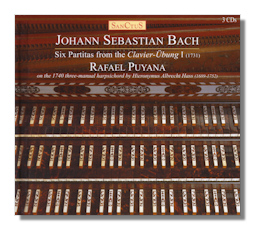
The Internet's Premier Classical Music Source
Related Links
- Bach Reviews
- Latest Reviews
- More Reviews
-
By Composer
-
Collections
DVD & Blu-ray
Books
Concert Reviews
Articles/Interviews
Software
Audio
Search Amazon
Recommended Links
Site News
 CD Review
CD Review
Johann Sebastian Bach

Partitas from the Clavier-Übung I (1731)
- Partita #1 in B Flat Major, BWV 825
- Partita #2 in C minor, BWV 826
- Partita #3 in A minor, BWV 827
- Partita #4 in D Major, BWV 828
- Partita #5 in G Major, BWV 829
- Partita #6 in E minor, BWV 830
Rafael Puyana, harpsichord
Sanctus SCS027-29 3CDs
Among the first of his works to be published (from 1726 to 1730/31) in the composer's own name – as the Clavier-Übung I – J.S. Bach's six partitas, BWV 825-830, constitute a set of six suites for keyboard. On this splendid three-CD set from Sanctus the late Columbian harpsichordist, Rafael Puyana (1931-2013), pupil of Wanda Landowska, plays the famous three-manual German harpsichord from 1740 by Hieronymus Albrecht Hass, which Puyana owned for half a century. Hass lived from 1689 to 1752, and was thus an exact contemporary of Bach.
Perhaps rather surprisingly, this is a new release of this major repertoire by a major performer, who – equally surprisingly – has fewer than a dozen CDs in the current catalog. It's certainly worth exploring, though.
Puyana's playing is consistent, consistently inspired and genuinely authoritative from first note to last without a hint of dogma, reduction or formula. Particularly impressive is his grasp and articulation of the rhetorical structure of Bach's noble yet unostentatiously-conceived suites… listen to the magnificent gigue [CD.1 tr.19] from the A minor, BWV 827, for instance. It has force, commitment and power. But in equal measure grace, poise and sensitivity. These qualities are expressed in ways that only come from a complete understanding of the composer's many intentions; coupled with a confidence that is conferred by real technical command.
The technique, though, is never nervous, showy, (self-)congratulatory, or even something to be gauchely concealed. It certainly suggests the lifetime of dedication which Puyana gave to this repertoire. Though of course innate adeptness and empathy with Bach's conception are just as necessary.
It's hardly fanciful to attribute Puyana's success in interpreting the essence of the Clavier-Übung I in no small part to the dream he inherited from Landowska to resurrect the Hass harpsichord. She first identified the instrument in 1900 as one which embodied many (most, even) of the merits of the German school of such instrument-making. The attachment to a vehicle contemporary with the music's composer must confer an ineffably special sense on the music's representation; perhaps just a little less effort is needed on the performer's part to have the music speak for itself.
This Puyana does in no small measure. His tempi and sense of architecture, the relative weights which each movement (and each passage, bar even) within each movement carry and bring to life, yet the holistic almost effortless communication of Bach's profundity and beauty all coalesce wonderfully well throughout this series of performances.
Another aspect of this set is the balance which Puyana strikes between providing us with a kind of colorful yet none too personal "reference" recital and a series of thoughtfully-crafted interpretations. Aware of the history of the instrument and Puyana's relationship with it, it's hard not to experience this as a (discographical) "event". But it's rather an exposition of this intriguing and forward-thinking area of Bach's composition.
At the same time, though, there is nothing mundane about these performances. They are a superb mixture of consistency and color. As each new movement begins you are struck by Puyana's unassuming confidence: he has internalized all aspects of the music. As each piece ends, his perception leave you anticipating the next. Throughout you are glad that Bach's essence is being presented with minimum fuss or gloss.
The acoustic in which these recordings were made is somewhat dry and closed. It concentrates the ear on the instrument, and Puyana's relationship with it. Each resonance, nuance and particularity of sound is here for the taking. But at the same time an overall sense of a keyboard doing a job is present. Ideal in many ways.
The three CDs come in a "presentation"-style, richly-illustrated, hardback book in English, French and German; the bulk of this is a movement by movement analysis and description of the works. It's tempting to say that this alone is worth the (very reasonable) price of this set. It has both the air and precision of an expert calmly unveiling works which understandably shocked those who heard them in Bach's era. The shock then melts into admiration at the music's virtuosity, breadth, depth and variety. However many other recordings of this repertoire you have, this is one to add. Puyana's approach, playing and indeed rounded relationship with the Partitas are likely to be ones of which you won't grow tired; and ones which will continue to provide new insights and delights almost indefinitely.
Copyright © 2014, Mark Sealey





















